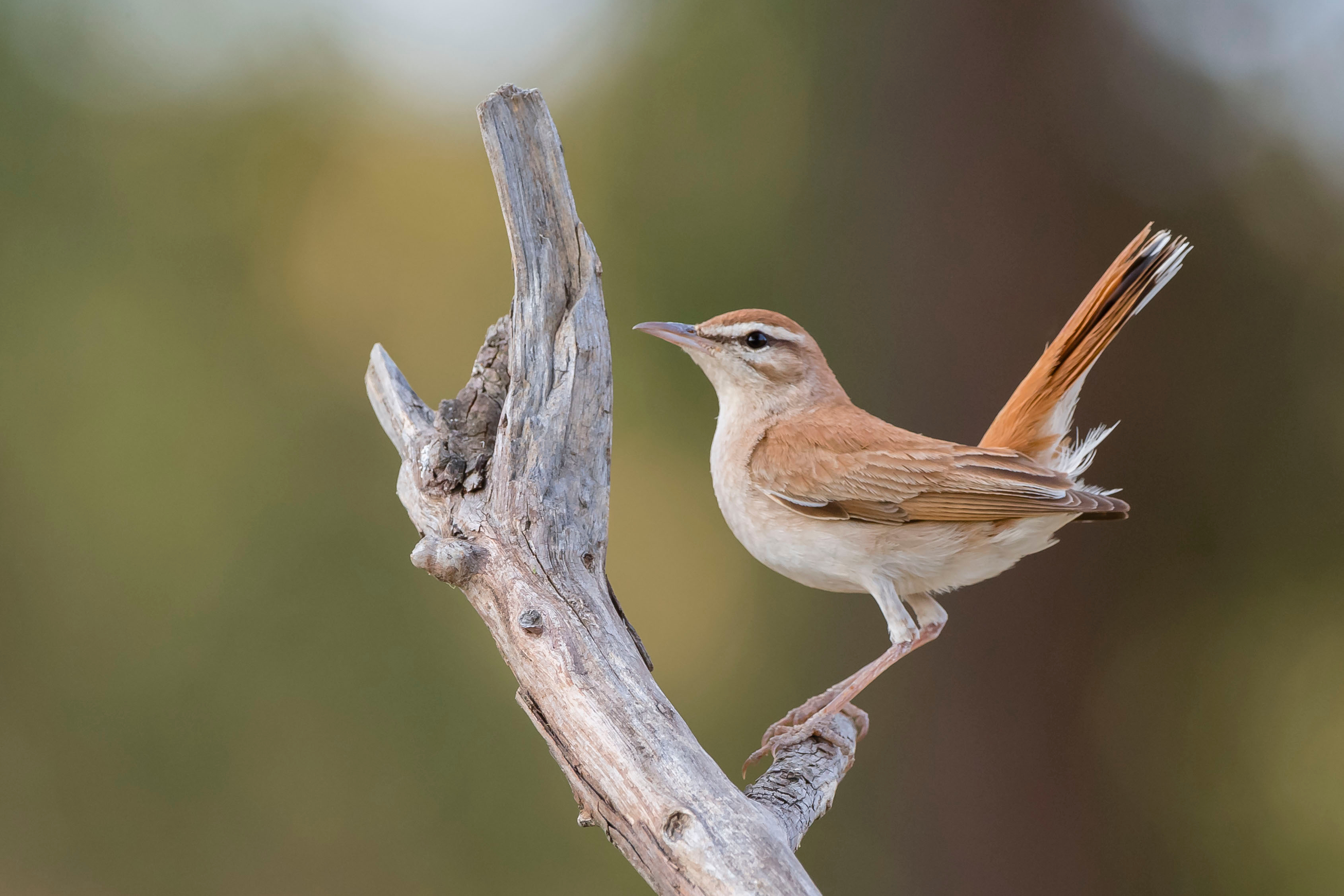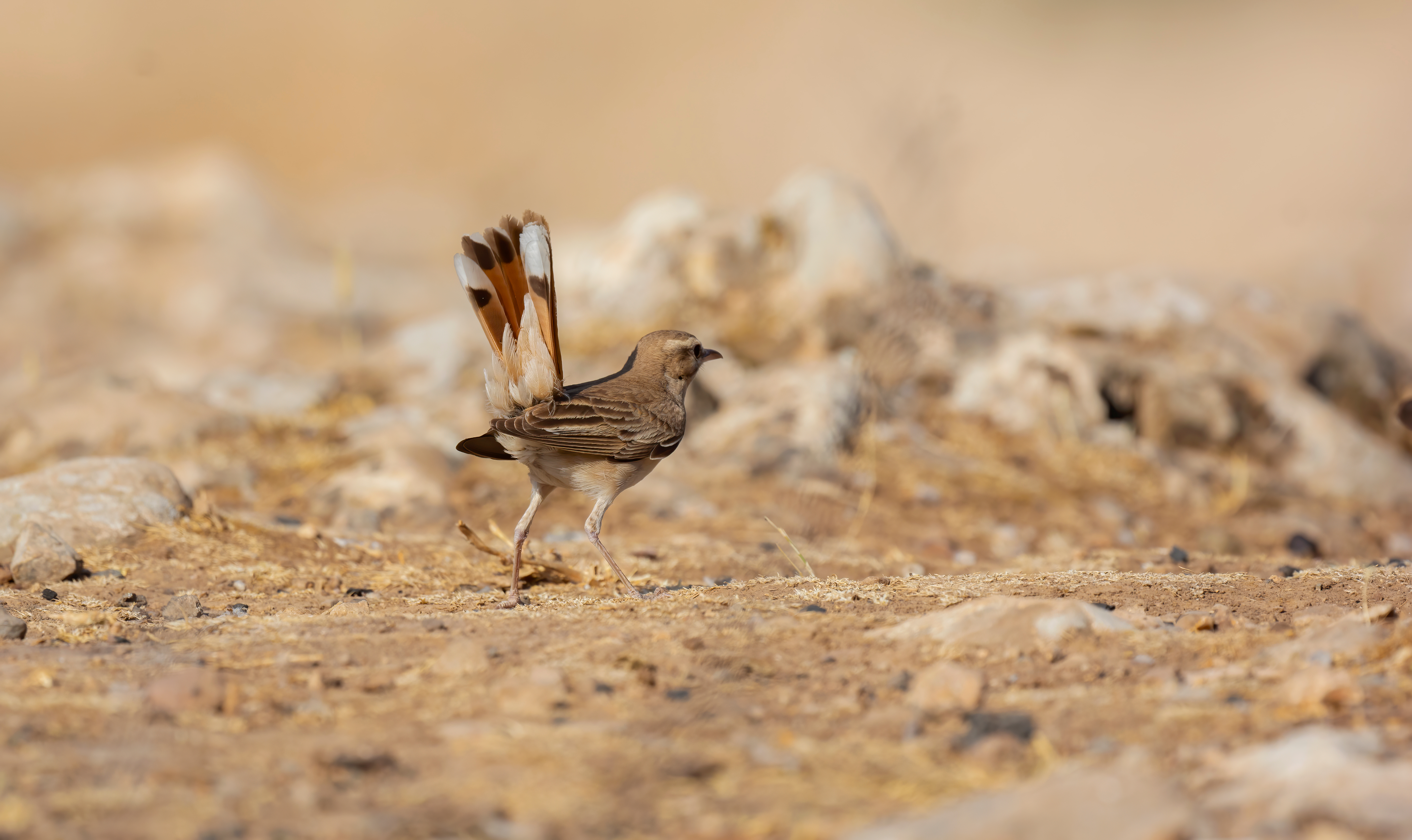The rufous-tailed scrub robin: the wine bird
If there is one bird with close links to the world of wine, it is the rufous-tailed scrub robin (Cercotrichas galactotes), one of the most threatened species in Iberian avifauna, which lives in dry woody crops, and especially in vineyards, its preferred habitat.
It has a slender figure and discreet plumage, with dark brown shades on its upper body and somewhat whiter shades on its chest and belly, and is a medium-sized bird: slightly larger than a sparrow, but smaller than a blackbird. Despite its mimetic colouring, the scrub robin is very easy to identify, thanks to its long reddish tail that moves up and down constantly and is often splayed in a fan shape.

A rufous-tailed scrub robin on a tree branch
Since its diet is basically insectivorous, this restless bird usually goes searching for its prey under olive trees or vines. To make the insects move so it can find them, the bird tends to move around flapping and waving its long tail. This is how it gets grasshoppers to jump and sends ants and beetles running.
It is also able to catch flying insects in the air, from mosquitoes to butterflies, even daring with larger species such as dragonflies, cicadas, or mantises. It may occasionally complete its diet with berries and wild fruits.
This elegant relative of the nightingale has one of its last strongholds in Europe on the Iberian Peninsula and is one of the great attractions for ornithological tourism. Every year, birdwatchers from all over Europe travel to the scrub robins’ most recent breeding areas, located mainly in the Guadalquivir River basin and Andalusian coast.
Nevertheless, it is not at all easy to spot these birds given the critical situation the species is in. The last census conducted by the SEO/Birdlife conservation organization confirmed the strong decline of its populations in our country and warned of the serious risk of extinction it is facing. For this reason, and to raise awareness of the alarming status of its populations and promote its conservation, the NGO chose this bird as its 2022 Bird of Year after holding a popular vote.

A rufous-tailed scrub robin
With a 94.8% decrease in Spain overall, Spanish ornithologists have asked the International Union for Conservation of Nature (IUCN) for the rufous-tailed scrub robin to be included in the list of endangered species, sharing this status with other more threatened species in our country, such as the bearded vulture, the Iberian lynx, the imperial eagle, and the brown bear.
The abandonment of traditional growing methods in the field, the increased use of weed killers and insecticides, and the transformation of old olive groves into intensively and super-intensively managed olive groves are some of the reasons for its decline.
As SEO/Birdlife reports, the majority of rufous-tailed scrub robins were found in the 1960s and 1970s in old olive groves, which were not grown uniformly at that time but were instead made up of a series of small plots with abundant herbaceous and shrubby vegetation at the edges forming hedges.
Interspersed with grains and vineyards, olive groves formed part of a mosaic that was perfectly integrated into the natural environment, home to abundant and rich biodiversity, especially insects: the basis of the diet of the rufous-tailed scrub robin and many other species in the agricultural environment. Today, this nutritious food chain that supported the steppe bird populations has been reduced to a minimum, in turn causing the decline of most species.
Moreover, the situation has worsened considerably in recent years with the so-called fertigation system, consisting of adding chemical fertilizers to the irrigation water itself.
This system—widely used in intensively managed olive groves and other crops—represents a deadly trap for the scrub robin and other birds who live on rainfed land, who, due to the lack of water availability in the natural environment, have become accustomed to drinking from irrigation sprinklers or the puddles that form on farms. As a result, they get poisoned and die.
Recovering good practices in the field, such as those promoted by regenerative agriculture, is the strategy that can best slow down the decline of rufous-tailed scrub robin populations and prevent their disappearance from the olive grove and vineyard environment, where they had always lived in perfect harmony with humans.
